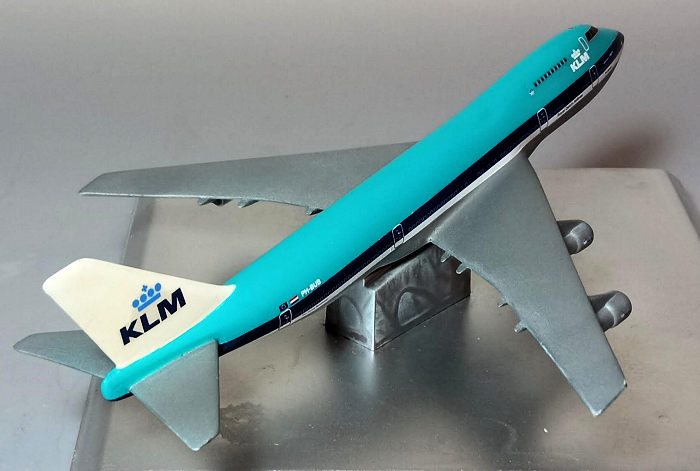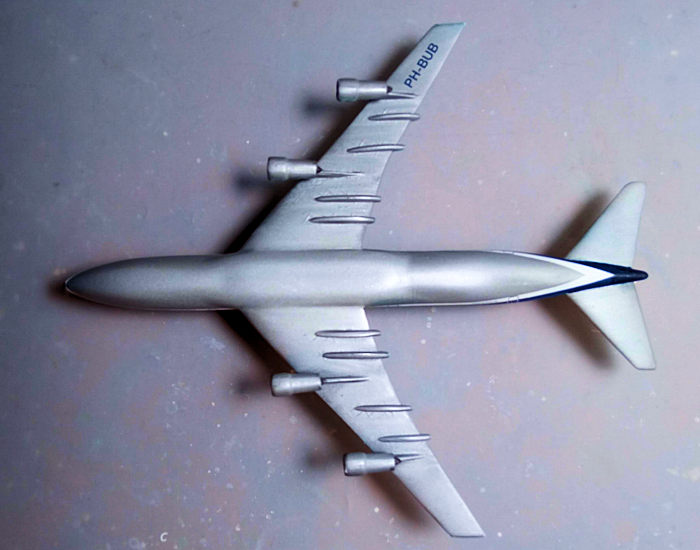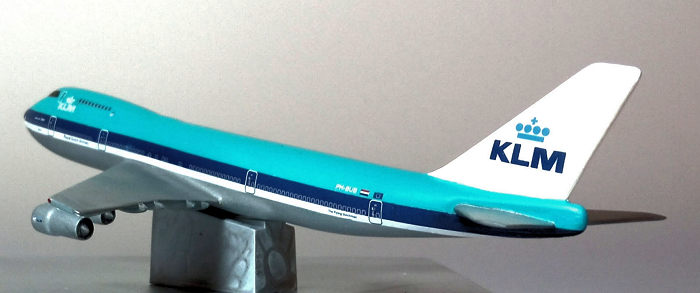
Revell 1/450 B.747-500
| KIT #: | 03999 |
| PRICE: | $6.000 |
| DECALS: | One Livery |
| REVIEWER: | Spiros Pendedekas |
| NOTES: | 1974 Heller tooling |

| HISTORY |
Koninklijke
Luchtvaart Maatschappij N.V. (KLM) is the national carrier of The
Netherlands. Headquartered in Amstelveen, with a hub at the nearby Amsterdam
Schiphol Airport, it is part of the Air France-KLM group and is a member of
the SkyTeam airline alliance. Founded in 1919, it is the world's oldest
airline still operating under its original name.
KLM's first flight took place on 17 May 1920 from London Croydon Airport to
Amsterdam, carrying two British journalists. In 1921 the airline began
regular flights, using mainly the Fokker F.II and F.III, with its first
transcontinental flight taking place on 1 October 1924. Long-haul flights
began in 1929 to Jakarta in the then Dutch East Indies, using the Fokker
F.VII.
 In May
2004, the company was acquired by Air France, with both companies keeping
their brands and fleets, while automatically becoming subsidiaries of parent
Air France-KLM. In the meantime, the long-standing partnership between KLM
and Northwest Airlines is not set to end, with both becoming members of the
SkyTeam airline alliance in September 2004.
In May
2004, the company was acquired by Air France, with both companies keeping
their brands and fleets, while automatically becoming subsidiaries of parent
Air France-KLM. In the meantime, the long-standing partnership between KLM
and Northwest Airlines is not set to end, with both becoming members of the
SkyTeam airline alliance in September 2004.
As of 2023, KLM operates regular passenger and freight services to
approximately 130 destinations, having a reputation as one of the safest
airlines in the world.
Among its historical fleet were the very successful Boeing 747-200 series,
which KLM started operating from as early as 1971. In total, 24 examples of
various -2xx subtypes were utilized, with the last ones retiring in 2003.
S/n 19923 was one of these machines, the second example received by KLM in
4-3-1971. Registered as PH-BUB and named Donau/The Danube, she proudly
served the airline till 06/11/1989, where she was handed over to America
West Airlines, before being scrapped in 1995
| THE KIT |
This small scale kit was
first issued by Heller in 1974, then reboxed another nine times from Heller
itself, Lodella, Blue Ribbon Collectors Series (lovelily marketed bagged, just
like old times) and Revell (in two versions, “standalone” and “Model Set”, the
latter including paints, glue and a paintbrush). The specific kit is the Revell
“standalone” version, bought for a mere $6 from a vendor during a model
show/contest that took place in March 2023 in my hometown, Chalkis, Greece.
The kit comes in a small side opening “Revell style” blue box of good quality,
carrying a nice box art of the kit subject, which is KLM’s PH-BUB machine. Upon
opening the box, I was greeted with 22 white styrene pieces, arranged in two
equally sized sprues. Molding is definitely old school, with raised panel lines
that are vastly off scale (in fact, given the minuscule 1/450 scale, maybe
totally sanding away panel lines may yield a more “correct” look). A good amount
of flash is evident and will have to be cleaned off.
 Apart from
the main parts’ seemingly correct general shapes, there are no other details to
speak of. The engines are very simplified, not even featuring a hollowed
compressor face. Landing gear is absolutely toy-ish and there are neither wheel
bays nor doors. Of course, most of the above “simplifications” can be somehow
justified by the kit’s small scale and mold origins.
Apart from
the main parts’ seemingly correct general shapes, there are no other details to
speak of. The engines are very simplified, not even featuring a hollowed
compressor face. Landing gear is absolutely toy-ish and there are neither wheel
bays nor doors. Of course, most of the above “simplifications” can be somehow
justified by the kit’s small scale and mold origins.
There are no transparencies whatsoever, all glazing having to be replicated by
decals. Instructions come in the form of a double folded A2 paper, featuring a
short history of the type, a parts diagram, with the simple construction spread
in 6 very clear steps.
Only one, very charming KLM scheme is provided, with two alternate
registrations. Colors are given in Revell codes, but also in generic form.
Decals are superbly printed, presumably by Cartograf, promising to significantly
boost the looks of the completed model.
Instructions want you to first join the fuselage halves, trapping 5 grams of
weight in the nose, then assemble and attach the aerodynamic surfaces, engines
and wheels, ending a build that could not be simpler.
| CONSTRUCTION |
 I started
by joining the fuselage halves. Due to the toy-ish landing gear looks, I decided
to build it as a desktop model in flying status and this was the reason I did
not add any weight in the nose. The wings were then assembled and attached,
followed by the horizontal stabilizers, with all aerodynamic surfaces aligned by
consulting the handy head-on drawing Revell provides. Once dry, the four engines
were assembled and attached, ending the ultra-simple build sequence.
I started
by joining the fuselage halves. Due to the toy-ish landing gear looks, I decided
to build it as a desktop model in flying status and this was the reason I did
not add any weight in the nose. The wings were then assembled and attached,
followed by the horizontal stabilizers, with all aerodynamic surfaces aligned by
consulting the handy head-on drawing Revell provides. Once dry, the four engines
were assembled and attached, ending the ultra-simple build sequence.
Overall fit was average, with all joints needing some attention, but it was an
easy task due to the model’s small size and simplistic layout. The three holes
where the landing gear struts were supposed to be attached were filled with
styrene pieces.
I decided to completely sand off the vastly off-scale raised detail (in fact, I
believe in 1/450 the panel lines would be hardly noticeable) and, after a
filling and sanding round, I took the small model to the paint shop!
| COLORS & MARKINGS |
I first gave the fin a coat
of Hu130 Satin White, which dried to an “ivory” shade, reminding me that I have
to somehow renew my aging white supplies. After masking it off, I gave the t opsides
a coat of Hu89 Middle Blue and masked it as well, followed by applying Hu56
Aluminum to all remaining surfaces. I decided not to go for the dual metallic
shade observed at the airliners wings, mostly due to my laziness and, maybe,
because the effect would not be too noticeable at this scale. A coat of Future
prepared the bird for decaling.
opsides
a coat of Hu89 Middle Blue and masked it as well, followed by applying Hu56
Aluminum to all remaining surfaces. I decided not to go for the dual metallic
shade observed at the airliners wings, mostly due to my laziness and, maybe,
because the effect would not be too noticeable at this scale. A coat of Future
prepared the bird for decaling.
I used the kit decals, in order to depict PH-BUB “Donau - The Danube”, as it
stood in 1989. The Cartograf decals behaved very well and really brought life to
this simplistic model. Making the decals conform to the nose was not as
difficult as initially feared, where I used strong decal softener, in order to
gradually and carefully make them conform. A coat of Future sealed them, with
the inevitable touch ups taking place soon after, including hand painting of the
very small, almost barely noticeable, black nose radome.
| FINAL CONSTRUCTION |
I could not live with the
engines’ bland faces, so I went on and drilled out their openings. The now
hollowed innards and the exhausts were painted Testors Burned Metal. Whereas
still not realistic, the net result of the engine looks with the now opened
intakes was more pleasing and less toy-ish, the lack of internal detailing being
not too noticeable at this ultra small scale.
 Though
tempted, I refrained from replicating the (nonetheless distinctive) teeny tiny
HF aerials located at the wingtips, since they would be snapped away at no time
from my young sons, eagerly waiting to play with the “blue and white plane". A
satin coat gave the bird its final hue.
Though
tempted, I refrained from replicating the (nonetheless distinctive) teeny tiny
HF aerials located at the wingtips, since they would be snapped away at no time
from my young sons, eagerly waiting to play with the “blue and white plane". A
satin coat gave the bird its final hue.
I modified a leftover base from the now defunct 1:100 "Collection Armour"
diecast aircraft series and mounted the model on it. Blobs of red and green
clear paint were applied, in order to simulate the wingtip lights, before
calling this very charming queen of the skies done!
| CONCLUSIONS |
Though getting elderly,
this is a good small scale kit of the iconic Jumbo Jet. With relevance to the
very small scale, general shapes of parts are for the most part correct, with
the exception of the engine faces that are bland and the landing gear that is
toy-ish. Panel lines are grossly overscale and sanding them off might be the
best option, accuracy-wise.
Molding itself is average with quite some flash that will have to be cleaned and
fit will require your attention, but nothing too serious, especially for such a
small, simple model.
The decal sheet, a most essential aspect for small scale airliners (since it
additionally replicates the transparencies and other structural details), is
supreme (what we have come to expect from Cartograf), promising to boost the
final model looks to a level met at bigger scales.
Presumably, a number of modelers will overlook this kit, due to, among possibly
others, its simplicity and small/odd scale, but, truth is that this very cheap
and easily found fellow offers a pleasant build and, with some extra attention,
can yield a nice result, with the simplicity of construction deeming it a good
candidate for introducing a youngster to the magic world of modeling.
Happy Modeling!
12 June 2023 Copyright ModelingMadness.com.
All rights reserved. No reproduction in part or in whole without express
permission. If you would like your product reviewed fairly and
fairly quickly, please
contact
the editor or see other details in the
Note to
Contributors.